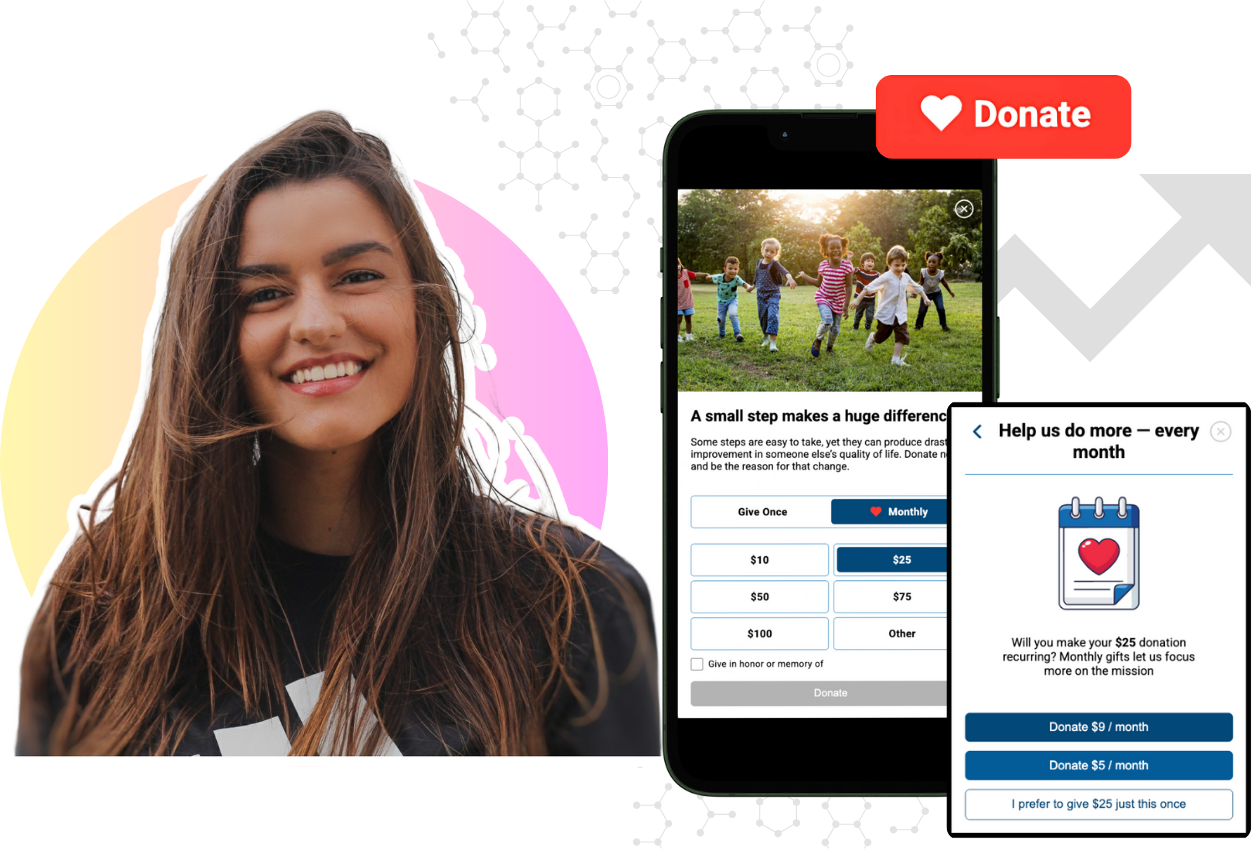Why Younger Donors Aren’t Donating Their “Stuff”
We all know the importance (and difficulty) of connecting with younger donors, but there might be some very simple things your organization can do to...

Mobile-First Pop-Up Donation Form
Launch mobile-first pop-up forms in minutes, use built-in tools to capture more donations, and optimize the giving experience—no dev team required.
New to online donation pages for your nonprofit? Start here.
Donation page A/B testing - no science degree needed.
Keep your donation page loading fast - and drive higher conversions.

The 4 Types of Online Donation Experiences
89% of donors leave without giving. Learn how to use the right donation form to close the gap and boost conversions.

While your supporters, in the end, will be the ones who determine whether or not your campaign is successful, it’s up to your team to build the best foundation for success that it can.
While every nonprofit’s end goal and mission will be different, there are some fundraising best practices that everyone should keep in mind while determining their overall approach to the campaign.
The 5 most important things to keep in mind while building your fundraising strategy are:
This aspect of fundraising may seem harsh, but it will improve your strategy for your upcoming campaign as well as your overall fundraising abilities for the future.
Like a football player watching footage of himself after a game, a nonprofit should consider their own previous fundraising strategies when planning their next campaign.
Objectively evaluating what did or didn’t work is a surefire way to ensure that your team is always moving in the right direction.
Did you have a particularly successful capital campaign? Do your annual fund drives always fall a little short? Some questions that you might ask yourself while considering your past fundraising campaigns are:
The point of this exercise is to learn from the past, not repeat it. Ask everyone on your team what they thought went well, or what they thought was a terrible idea.
You might find that low-level supporters responded well to personalized solicitation letters, or that your mid-level giving population was not nearly as engaged in your campaign as you wanted or needed them to be.
Incorporate whatever you learn from your analysis into your fundraising strategy for this campaign. Remember, different tactics work for different contributors, so segment your community by demographic markers and tailor your marketing and solicitation strategies to be more effective.
Choosing a feasible yet ambitious fundraising campaign goal is an important step when crafting a fundraising strategy. So how can your nonprofit determine what an appropriate fundraising goal is?
Ask yourself and your team some of these questions to get you on the right track:
These questions can help you pin down a solid and achievable goal. But that’s not the only important part of deciding upon a campaign goal—you have to know where the funds are going to come from before you start fundraising!
The key to this strategy will be crafting a gift range chart.
A gift range chart is a document for your fundraising team that breaks your campaign goal down into different levels of giving—low-level, mid-level, and major gifts—and determines how many prospects your team needs to solicit to reach that goal.
Because not every one of your team’s solicitations will be successful, your team needs a few more prospects than necessary. Depending on the size of your campaign, you might be able to find enough support within your existing supporter population, or you’ll have to conduct prospect research to grow your community.
Determining what your campaign goal is and where the funds will come from are both important steps in crafting a successful campaign.
When planning a campaign, your team needs to remember to set themselves up for success all the way through till the end.
To keep your campaign on track and ensure that you’re going to reach your goals, identify KPIs, or Key Performance Indicators, before the campaign gets started.
Key Performance Indicators are quantifiable measures used to evaluate the success of the campaign, and your team can use them to create benchmarks for your campaign to ensure that your fundraising team is on track to meet their goals.
What are some Key Performance Indicators that your nonprofit can set to ensure that you’re going to reach your goals when you need to?
While the KPIs that your nonprofit tracks will be dependent on your unique goals and strategies, every nonprofit should recognize that KPIs are a valuable tool for fully understanding their successes and weaknesses.
In addition to showing you how your fundraising campaign is doing, tracking KPIs allows you to compare your current efforts to past efforts. If this is your first time tracking KPIs, they will give you a quantifiable baseline to compare your future campaigns against.
You can link a certain KPI to a point on your timeline, so that your nonprofit knows for sure that they’re on the right track. When do you need to have raised 50% of your fundraising goal by? 75%?
While nonprofits are built on the hearts and souls of your team members, tracking nonprofit analytics can help your team stay on track and be as effective as possible when fulfilling your mission.
Any time that your nonprofit decides to embark on a large fundraising campaign, you should conduct a fundraising feasibility study.
A fundraising feasibility study is comprised of a series of interviews with nonprofit stakeholders, prospective major givers, and important community supporters.
Then, after the interviews are over, you analyze your findings to determine if you have the institutional infrastructure, experience, and community support necessary to succeed in your campaign.
During your fundraising feasibility study, you might learn that:
Once you’ve completed your fundraising feasibility study, you need to keep the results in mind while planning your fundraising strategy. Use your study to identify any weaknesses in your strategy, and then improve it.
Ignoring the results of your fundraising feasibility study will only spell doom for your fundraising campaign. To ensure that you’re conducting the best study you can, check out this guide to feasibility studies as well as sample questions from Averill Fundraising Solutions
Even though your timeline, goal, and KPIs are all planned out now, your team isn’t done. The last thing you need to keep in mind while planning your fundraising strategy is your case for support.
Your case for support is one of the most important documents that you’ll create for your fundraising campaign. It’s a supporter-facing document that details your organization’s mission, long-term, and short-term plans.
The point of this document is to convince your givers (but especially your major givers) why they should give to your nonprofit during this campaign.
Again, the true content of your case for support will vary based on your nonprofit and specific campaign, but there are a few general best practices that can ensure you’ll write the best possible case for support.
If your team has ever written an annual fund appeal, you’ll already have the basics down. But for those who haven’t, we’ll break it down further.
What are the key ingredients for your case for support?
Once you have the bare bones of your case for support, flesh it out with the details that make your nonprofit special. The case for support is where your nonprofit gets to tell its story to the potential giver and explain why you do what you do.
While fundraising relies on person-to-person interactions, your case for support allows your nonprofit to make sure they put their best foot forward, every time.
Building a fundraising strategy from the ground up can seem like an overwhelming task, but never fear. By listening to what your givers are telling you, learning from your previous campaigns, and taking advantage of all available resources, you can get your fundraising strategy up and running in no time.

We all know the importance (and difficulty) of connecting with younger donors, but there might be some very simple things your organization can do to...

Donor centricity is the principle that is first in line for building a Connected Giving experience. Your end goal is to increase online donations....